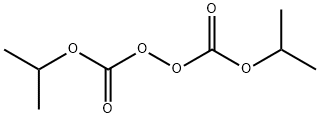CHEMICAL AND PHYSICAL PROPERTIES
| Physical Description | Diisopropyl peroxydicarbonate appears as a white solid (shipped packed in Dry Ice to stabilize) with a sharp unpleasant odor. Insoluble in sater and sinks in water. Used as polymerization catalyst. (USCG, 1999) |
|---|---|
| Color/Form | Crystalline solid |
| Melting Point | 50 °F (USCG, 1999) |
| Solubility | Almost insol in water; miscible with aliphatic and aromatic hydrocarbons, esters, ethers and chlorinated hydrocarbons |
| Density | 1.08 at 59 °F (USCG, 1999) - Denser than water; will sink |
| Decomposition | Spontaneous decomposition at room temperature releases flammable and corrosive products. |
| Refractive Index | Index of refraction: 1.4034 @ 20 °C/D |
| Other Experimental Properties | SELF-ACCELERATING DECOMP TEMP 53 °F |
| Chemical Classes | Other Classes -> Peroxides, Organic |
COMPUTED DESCRIPTORS
| Molecular Weight | 206.19 g/mol |
|---|---|
| XLogP3 | 2.6 |
| Hydrogen Bond Donor Count | 0 |
| Hydrogen Bond Acceptor Count | 6 |
| Rotatable Bond Count | 7 |
| Exact Mass | 206.07903816 g/mol |
| Monoisotopic Mass | 206.07903816 g/mol |
| Topological Polar Surface Area | 71.1 Ų |
| Heavy Atom Count | 14 |
| Formal Charge | 0 |
| Complexity | 176 |
| Isotope Atom Count | 0 |
| Defined Atom Stereocenter Count | 0 |
| Undefined Atom Stereocenter Count | 0 |
| Defined Bond Stereocenter Count | 0 |
| Undefined Bond Stereocenter Count | 0 |
| Covalently-Bonded Unit Count | 1 |
| Compound Is Canonicalized | Yes |
PRODUCT INTRODUCTION
description
Diisopropyl peroxydicarbonate appears as a white solid (shipped packed in Dry Ice to stabilize) with a sharp unpleasant odor. Insoluble in sater and sinks in water. Used as polymerization catalyst. (USCG, 1999)
